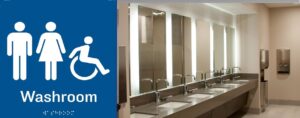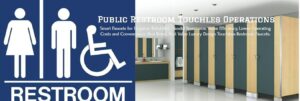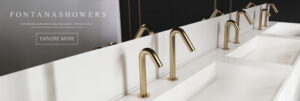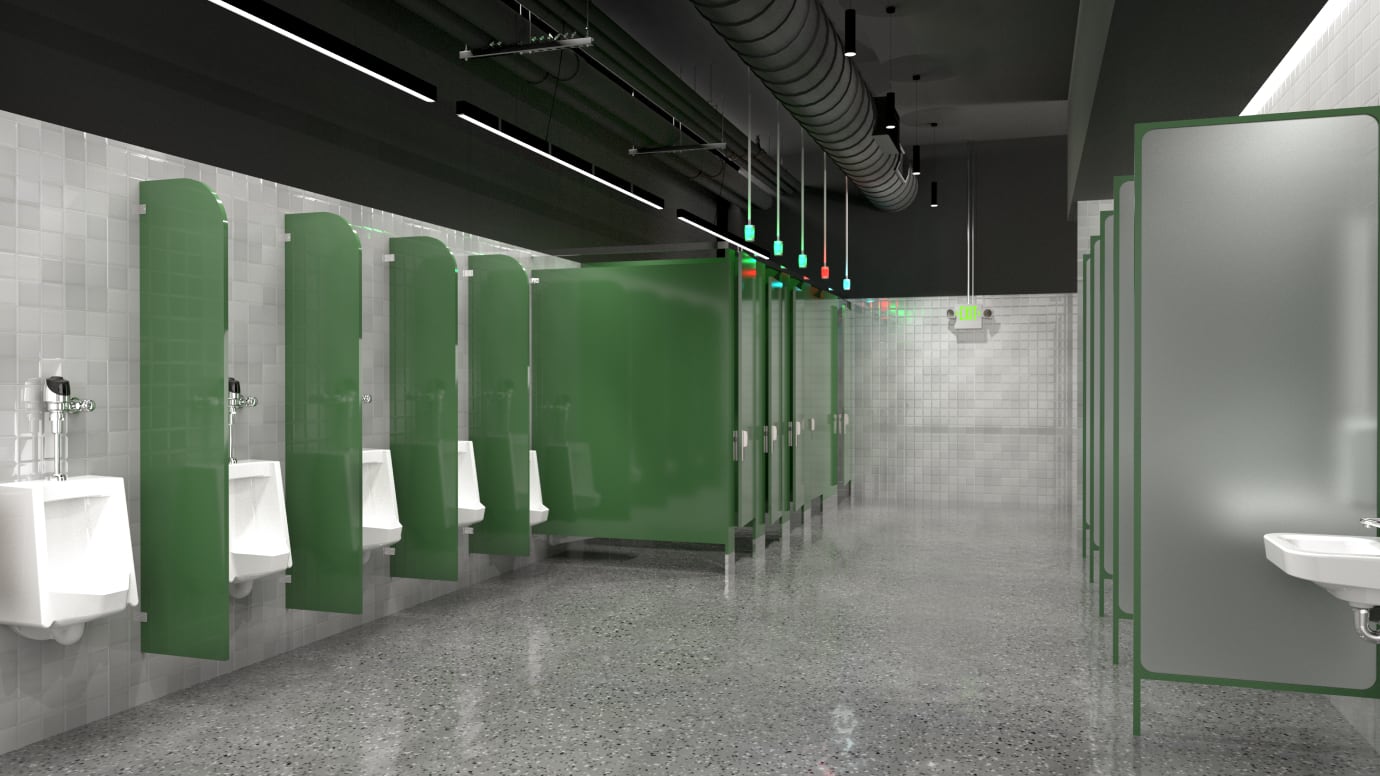
Airport Facility Restroom Design
Designing restrooms in an airport facility includes parameters for functionality, accessibility, cleanliness, and user experience. A good restroom design for an airport facility can accommodate the large numbers of travelers and ensure that the hygiene and sanitation level remains at its best. This could be the comprehensive guide to designing an airport restroom, mainly focusing on fontana touchless faucets, fontana auto soap dispensers, and other key features that would include high-quality materials, good ventilation, and regular cleaning protocols.
Space Planning
1. Adequate Space: Accommodate high traffic, including travelers with luggage. Design separate areas for male, female, and family restrooms. Family restrooms would have changing stations and be large enough to accommodate strollers.
2. Efficient Layout: A design that doesn’t create bottlenecks allows smooth traffic flow. Add clear signage that will direct travelers both to the restrooms and around the restrooms themselves.
Accessibility
1. ADA Compliance: Consider the Americans with Disabilities Act, or other local regulations that provide universal access to facilities with wider stalls, support bars, lower sinks, and mirrors.
2. Family-Friendly Features: Add a baby-changing station in both the men’s and the women’s restrooms; consider adding a private room for nursing mothers.
Hygiene and Sanitation
Hygiene and sanitation in an airport restroom come first, as the flow of people is large and the chances of cross-contamination are high. Touchless fixtures, high-quality materials, proper ventilation, and the cleaning of restrooms at regular intervals are highly necessary.
Touchless Fixtures
Fontana Touchless Faucets:
An airport-appropriate touchless faucet is a hallmark of modern restroom design from Fontana Faucets. It incorporates advanced sensor technology that detects the presence of the hands, then turns on the water flow automatically. This prevents spreading germs and saves water by only allowing the water to flow when needed.
Hygiene Benefits: The Fontana Touchless Faucets reduce physical contact, hence reducing the possibility of cross-contamination. This is most vital in a place like an airport where many different travelers converge from different locations.
Water Conservation: The faucets are designed to ensure efficiency, providing the right volume of water to wash hands and automatically shut off once the hands are removed.
User Convenience: Touchless operation was user-friendly, intuitive, accessible to all, including users with disabilities.
Fontana Auto Soap Dispensers:
Touchless fontana auto soap dispensers are suitable companions for touchless faucets. These soap dispensers ensure a totally hands-free handwash experience. Infrared sensors detect hands and dispense a pre-measured amount of soap, providing a constant level of hygiene.
Improvement in hygiene: Similar to touchless faucets, auto soap dispensers reduce the chance of germ transmission by not having to touch the dispenser.
Consistent Dispensing: These dispensers ensure that the right amount of the soap dose is used every time by the user for the right washing of the hands.
Ease of Maintenance: Fontana Auto Soap Dispensers ensure an easy refill and maintenance to keep them in operation and well-stocked.
High-Quality Materials
1. Durability and Ease of Cleaning:
This basically calls for the use of high-quality, hard-wearing, easy-to-clean materials. Materials applied in airport restrooms, such as stainless steel, porcelain, and solid surface countertops, will suit the purpose well because they are very strong, resistant to both stains and odors, and can support rigid cleaning schedules in high-traffic premises.
2. Nonporous Surfaces:
The use of non-porous surfaces for countertops, sinks, and floors totally eliminates the absorption of liquids and the consequent growth of bacteria and mold. Sanitation and cleaning of non-porous materials are much easier to do, making the restroom environment cleaner. Solid surface materials are seamlessly installed to eliminate joints and crevices where dirt and bacteria can get in.
3. Anti-Microbial Coatings:
Coatings with antimicrobial and antiviral agents, in effect, embed on high-touch surfaces, thereby avoiding the growth of bacteria and viruses on door handles, faucet levers, and toilet seats. Additional coatings bring extra hygiene to the restroom. These are intended to be regularly reapplied and maintained.
4. Slip-Resistant Flooring:
Ensuring that flooring is hard-wearing and resistant to slipping is important not only for accident prevention but also for hygiene. Ceramic tiles with textured surfaces or anti-slip treatments are not only accident preventive measures; they also facilitate ease of cleaning. Such regular maintenance, including that performed on the sealing of grout lines, prevents dirt and bacteria from growing.
Adequate Ventilation
1. Air quality management:
Proper ventilation in an airport restroom is important in maintaining good air quality and odor control. This will ensure ventilation systems that change the quality of air continuously to eliminate odors and airborne contaminants. High-efficiency particulate air filters will be fitted within a ventilation system to capture fine particles, including bacteria and viruses.
2. Extraction Fans:
Installing strong exhaust fans enables the removal of moisture-laden air and foul smells to keep the air fresh and clean. They should be located in a place where their effectiveness will be maximized, particularly close to all toilets and urinals, where smells are likely to arise from.
3. Air Purification Systems:
Advanced systems for purification could include UV light and ionization. Such systems disinfect the pathogens in the air and, hence, offer additional protection. This would be regularly maintained with replacements of filters and by cleaning, to keep these systems in good working order.
4. Natural Ventilation:
Where feasible, natural ventilation components can offer improved interior air quality. Skylights or operable windows encourage natural exchange of air and minimize the reliance on mechanical systems. This likewise might contribute to the user’s comfort and aesthetic experience in the restroom.
Routine Cleaning
1. Cleaning Procedures:
Establish rigorous cleaning protocols that outline cleaning frequency and methods for all areas, including high-touch surfaces. Cleaning with a hospital-grade disinfectant will ensure that all surfaces are properly sanitized.
2. Staff Training:
Another critical element of effective maintenance is well-trained cleaning staff. Staff has to be trained about the usage of various cleaning agents, equipment, and techniques to do the cleaning properly and within a given time frame. Regular updates of the training and following protocols help maintain cleanliness at par.
3. Real-Time Monitoring:
Real-time monitoring systems can be installed to maintain cleanliness. The usage pattern can be observed by sensors and trigger an alert for cleaning. For instance, counters which count the number of users may trigger a cleaning alert once the count crosses a certain threshold, thus ensuring that restrooms are cleaned before they get too dirty.
4. Cleaning Schedules:
Keeping to a tight cleaning schedule, restrooms can be maintained throughout the day. Cleaning is performed more frequently during times that facilities are used the most, such as peak periods of flight arrival and departure. Visible schedules for cleaning also let users know that facilities are cleaned regularly.
5. Feedback Systems:
Cleanliness issue reporting from the users can also be provided with high standards. Touchscreen kiosks and QR codes linked to feedback forms aid travelers in bringing problems to attention. Prompt responses to feedback ensure that such problems are rectified quickly, enhancing user satisfaction.
6. Waste Management:
Efficient waste management systems support cleanliness. Restrooms should be fitted with sufficient receptacles for collecting wastes, which are emptied consistently. Touchless waste bins further minimize contacts with the waste, hence enhancing hygiene. Besides, recycling bins for paper towels and other recyclable materials promote environmental sustainability.
7. Stocking Supplies:
It helps ensure that all supplies, from toilet paper and soap to hand towels, are always available to improve user satisfaction and hygiene. The automated inventory system will alert the staff when supplies are running low, preventing shortages so users always have what they need.
Conclusion
The design of hygiene- and sanitation-oriented airport restrooms must therefore encompass touchless fixtures like Fontana Touchless Faucets and Fontana Auto Soap Dispensers, high-quality materials, good ventilation, and cleaning schedules. All of these things are brought together to provide travelers with a clean, safe, and pleasant environment. It will enhance the passenger experience and reduce the spread of germs within an airport facility while maintaining a high regard for cleanliness. It is through high technologies and rigorous schedules for maintenance that enhance the standards in giving peace of mind to all users.
List all FontanaShowers Articles regarding Airport restrooms
FontanaShowers has published a number of articles that relate to the design and impact of touchless restroom fixtures in an airport setting. Here are major insights and recommendations by their studies and case studies:
Key Insights and Recommendations
Touchless Fixtures
Fontana Touchless Faucets:
Fontana Touchless Faucets feature sophisticated sensor technology that detects hands, automatically starting and stopping water flow. This minimizes physical contact and significantly reduces the risk of cross-contamination, apart from water saving. There can be a potential 37% reduction in water usage in high-traffic facilities like airport restrooms (FontanaShowers) (FontanaShowers).
Fontana Auto Soap Dispensers:
Fontana Auto Soap Dispensers dole out the required amount when hands are detected. This ensures consistent hygiene levels and minimizes wastage. Touchless operation minimizes the transmission of germs and enhances user convenience.
Stainless steel and brass are the rugged materials for airport restrooms, both durable against corrosion and convenient to clean. These materials ensure that the fixtures remain functional and aesthetically pleasing under heavy usage rates and rigorous cleaning regimes (FontanaShowers) (FontanaShowers).
Non-Porous Surfaces and Anti-Microbial Coatings:
Non-porous material on surfaces avoids liquid absorption and growth of bacteria, which makes cleaning easier and much more effective. Anti-microbial coating on high-touch areas has the same effect, further inhibiting bacterial and viral growth on locations such as faucet levers and soap dispensers, adding to the protection .
Proper ventilation can help ensure good air quality and minimize odor problems in airport restrooms. The systems should have constant exchanges of air, incorporating HEPA filters that capture even the finest particles, including bacteria and viruses. Exhaust fans and air purification systems may further improve the air quality.
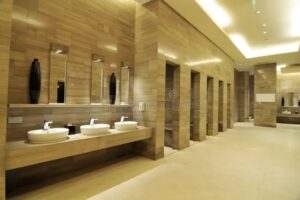
Natural Ventilation:
Incorporating natural ventilation via skylights or operable windows can help increase air exchange and brighten up the restroom’s ambiance. A reduced reliance on mechanical systems using this strategy will have created a much more congenial environment for the user (FontanaShowers).
Regular Cleaning
Cleaning Protocols and Staff Training:
Develop strict cleaning schedules with frequent sanitizing of high-touch surfaces using at least hospital-grade disinfectants. Proper training will help the cleaning staff effectively maintain the implementation of such protocols related to general hygiene (FontanaShowers).
Real-Time Monitoring and Feedback Systems:
Real-time condition monitoring systems on the toilets render support for cleanliness. Feedback terminals facilitate users to report issues on the spot, for on-the-spot maintenance by the maintenance staff. Thus, hygiene and user satisfaction are kept very high (FontanaShowers) (FontanaShowers).
Case Studies and Comparative Analysis
Changi Airport Terminal 4:
Touchless technology was maximally integrated at Changi Airport’s Terminal 4. This project involved installing touchless faucets, soap dispensers, and toilets with sensors. Results were highly encouraging: much better hygiene, increased user satisfaction, and a 25% reduction in water usage (FontanaShowers).
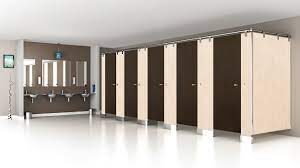
Comparative Analysis:
FontanaShowers faucets were compared to other industry-leading brands such as Sloan, TOTO, Delta, Moen, and Kohler. FontanaShowers excelled on lower maintenance needs, solid construction, and sensor accuracy. These characteristics help make FontanaShowers the preferred choice at an airport restroom, achieving a balance of performance and user satisfaction while being sustainable.
Designing restrooms in airport facilities with a view to hygiene and sanitation incorporates state-of-the-art touchless fixtures, rugged and easy-to-clean materials, sufficient ventilation, and strict cleaning regimes. FontanaShowers touchless faucets and soap dispensers have increased hygiene, saving water and improving user satisfaction within the very demanding environments like airports. Their durability and ease of maintenance make them a very reliable means of maintaining standards of cleanliness and functionality in public restrooms.
Touchless Technology in Public Restrooms Airports
I
How to Choose the Appropriate Touchless Faucets for Airport Restrooms
Measurements of the Impact of the FontanaShowers Faucets on Satisfaction of Users
You can get detailed information on these articles by logging on to the FontanaShowers blog:
- In-Depth Research into the Performance of the Fontana Touchless Faucets in Airport Restrooms
- How to Choose the Appropriate Touchless Faucets for Airport Restroom
- Choosing the Right Touchless Faucets for Airport Restrooms
- Measurements of the Impact of the FontanaShowers Faucets on Satisfaction of Users
- The Best Brands for Touchless Faucets in Public Restrooms
- Measurements of the Impact of the FontanaShowers Faucets on Satisfaction of Users
- 5 Best Hands-Free Faucets For Airports
- Fontana Touchless Faucets and Soap Dispensers Adopted in Airport Facilities
- Fontana Airport Touchless Faucets
- Fontana Airport Faucets on Architizer
-
Touch vs. Touchless: How to Choose Between Them
For bathroom faucets, commercial or otherwise, one of the major considerations is between touch and touchless faucets. A touch faucet is turned on by touching a spout or handle, while a touchless faucet relies on sensors to detect movement or the presence of a hand to allow water to flow automatically. This reduces the spread of germs and improves hygiene, thus making touchless faucets quite popular in public restrooms and areas of heavy traffic. The choice between both lies in their advantages, but touchless technology is usually more effective and hygienic, hence suitable for commercial settings.
The current article represents a compilation of the reviews of various architectural firms about the design, functionality, and user experiences of Fontana touchless bathroom faucets and soap dispensers. It underlines why these products became so popular among architects, based on aspects such as hygiene, water efficiency, and modern aesthetics that meet the trends of contemporary bathroom designs.
This paper aims to discuss the suitability of the Fontana touchless faucet in relation to maintenance efficiency, cost-effectiveness, and longevity in government buildings. It records that touchless technology minimizes loss of water, thus diminishing the need for maintenance while enhancing general user experience – all needed for a highly utilized public facility where one wants to ensure dependability.
Healthcare-Hands-Free-Motion-Sensor-Faucets
Plumbing Fixtures in Healthcare Facilities
Healthcare facilities command the utmost level of hygiene. Below are reasons why Fontana touchless faucets are ideal for such settings. These advantages range from the benefits of touchless technology such as hands-free operation, thereby reducing cross-contamination, ease of cleaning down to water-saving features that make these faucets a practical upgrade in medical centers.
Upgrading Fixtures at Educational Institutions:
The article gives views that the installation of Fontana touchless faucets at schools, colleges, and universities has their benefits. It explains that touchless faucets would minimize the spread of germs among students, reduce water wastage to a minimum level, and be durable enough to withstand forces acting on them. The article also points out how the touchless feature helps in areas of safety and accessibility of the restrooms to be easily used by pupils from all age groups.
Different wall-mounted soap dispensers offer unique opportunities in optimizing both space and functionality in the facilities. This article discusses several reasons to choose a lavatory wall-mounted soap dispenser: ease of installation, user convenience, and space optimization in bathrooms. Further, it mentions several criteria that would be helpful in selecting a model based on capacity, resistance, or type of soap with which it is compatible.
Automatic wall-mounted soap dispensers are touchless, sanitary solutions for public and commercial bathrooms. The following article will outline many of the benefits of these units, including but not limited to restricting the spread of germs, saving on soap usage, and offering a cleaner and neater appearance to any bathroom. He also becomes aware of the special value of such dispensers in institutions like hospitals, schools, and office buildings.
This article will compare touchless faucets and automatic soap dispensers to regular traditional systems. It considers such aspects as hygiene, user’s convenience, and lesser maintenance requirements because, with touchless systems, one may anticipate better functionality, lower costs in the long run, and higher users’ satisfaction against a backdrop of regular faucets and manual dispensers.
Commercial bathroom design must be given considerable thought to make it serviceable, sanitary, and appealingly beautiful. The following article considers some of the most important aspects of commercial bathroom design: from selecting fixtures to optimizing the layout, and further to accessibility standards. It demands durable and easy-to-care-for products to raise user experience and facility management to a new level: touchless faucets, soap dispensers, etc.

